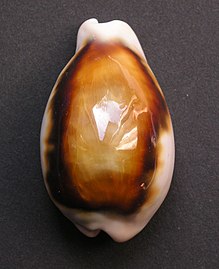|
Neobernaya spadicea
Neobernaya spadicea, common name the chestnut cowrie, is a species of sea snail in the cowrie family, Cypraeidae. Chestnut cowries can be found in the eastern Pacific Ocean, from central California to Baja California. The chestnut cowrie has a highly glossy shell due to an enamel that is secreted from its mantle. Distribution and habitatThe chestnut cowrie is the only species of cowrie in the eastern Pacific Ocean.[1][2] It can be found in intertidal zones from Monterey, California to Isla Cedros, Baja California.[2][3] It is common in Southern California, specifically around the Channel Islands.[1][3] Chestnut cowries are rare in the portion of their range that is north of Santa Barbara, California.[4][3] Chestnut cowries live in kelp beds and rocky surfaces in intertidal and subtidal zones,[4][5] to a depth of 45 m.[2] Chestnut cowries are often found under rocks and protected crevices.[4][5] DescriptionThe top of the shell displays a large irregularly shaped caramel colored spot, with a dark brown border.[4] The rest of the shell is white, including the bottom.[4] There is a narrow aperture with small teeth that spans the length of the underside of the shell.[6] The shell can grow until the cowrie reaches its adult form, then it stops.[5] When undisturbed, their orange spotted mantle extends around the outside of the shell; when fully extended it can completely cover the shell.[4][5] The shell is glossy due to an enamel that is secreted from the edges of the mantle.[4] Retracting and extending the mantle acts as a buffer, shining the shell while depositing new enamel.[4] The foot of this species is white.[4] The adult shell of this species ranges in size from 40 to 65 mm.[1] EcologyDietThe chestnut cowrie is a scavenger and carnivore; common food items include anemones, sponges, tunicates, eggs, and dead organisms.[2][3] ReproductionChestnut cowries lay batches of eggs during the summer months.[3] Each batch consists of approximately 100 egg capsules with each egg capsule containing several hundred eggs.[3] References
|
||||||||||||||||||||||||||||||||||||



